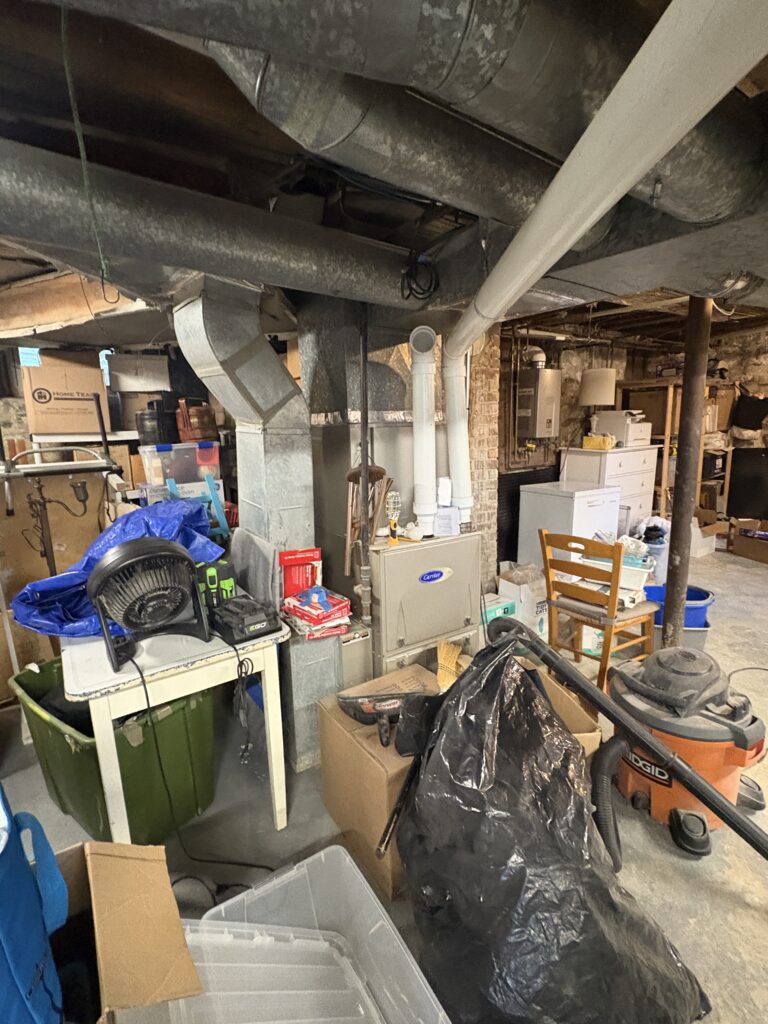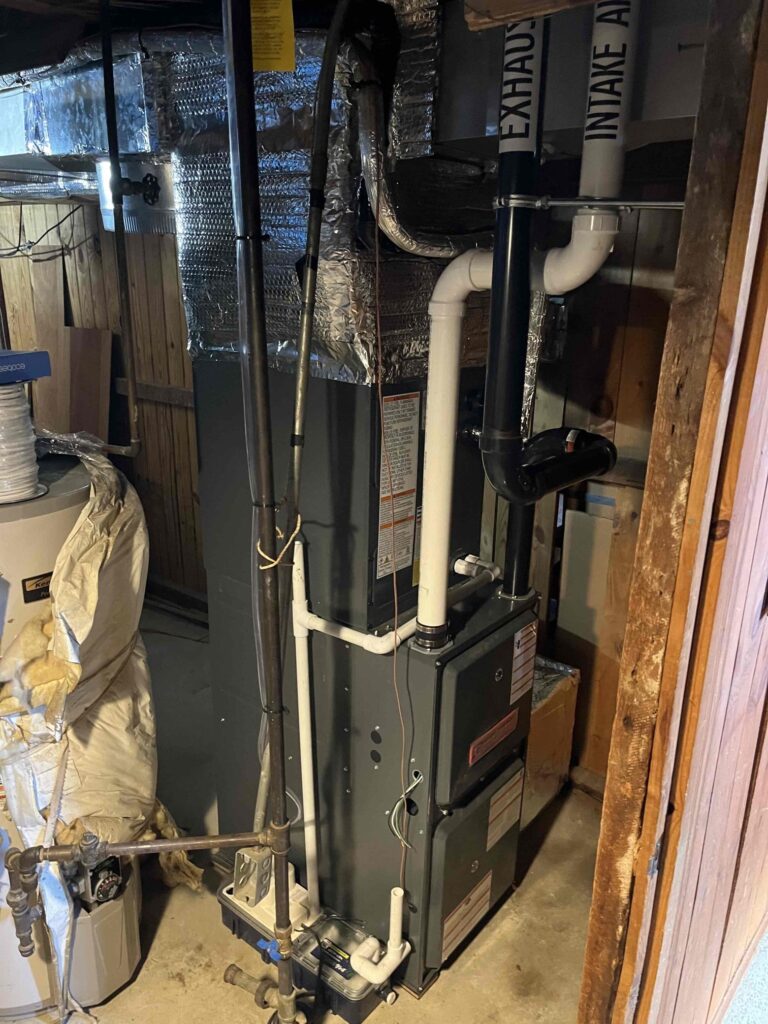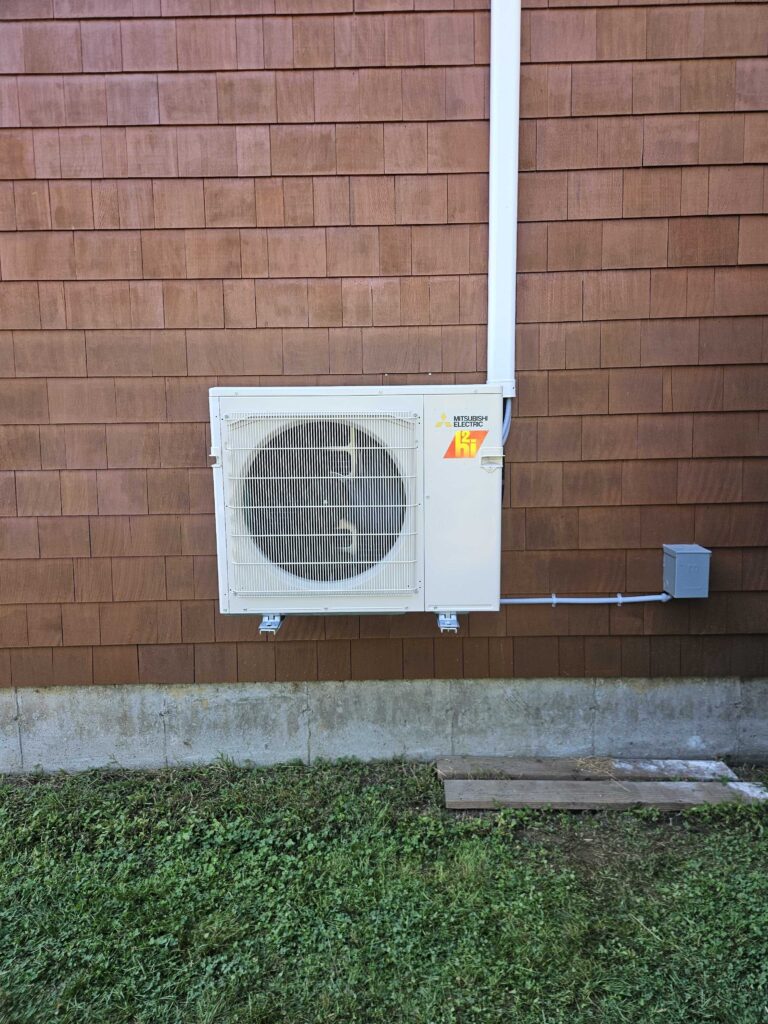Can You Add a Heat Pump to Existing Ductwork? A Massachusetts Homeowner’s Guide
If energy bills keep spiking in Framingham, Worcester or anywhere else in the Bay State, you’re probably looking for a smarter way to stay comfortable without draining your wallet. For many residents who currently rely on a furnace AC combo or an aging central AC, the obvious next question is can you add a heat pump to existing ductwork and leverage the same forced-air network to deliver efficient heating air and cooling throughout the home.
As Mass Save explains “Today’s cold climate heat pumps are 2-3x as efficient as a boiler or furnace and many provide efficient heat at outdoor temperatures as low as ‑15 °F.” Those numbers help explain why more homeowners are turning to all-electric heating and cooling that performs in frigid New England winters while lowering carbon footprints.
That popularity has generated a common question during our in-home consultations: Can you add a heat pump to existing ductwork, or will you need new ductwork designed and installed from scratch? Most households can reuse their existing ductwork when switching to a ducted heat pump, which keeps project costs lower and often limits installation to roughly one to three days.
In the sections that follow, you’ll learn how ducted heat pumps operate, how to know if your ducts are ready and why pairing the right system with Mass Save® incentives can unlock significant savings, comfort and year-round heating and cooling flexibility.
Table of Contents
ToggleUnderstanding Heat Pumps and Existing Ductwork
A heat pump works a lot like a refrigerator in reverse. Instead of creating heat, it moves it. In winter the outdoor condensing unit extracts warmth from the outside air, compresses it and sends it indoors, where an air handler pushes the conditioned air through your forced-air ducts. In summer the cycle reverses to pull heat from your home and vent it outdoors so the same ducts deliver cool air.
Because the same equipment can heat and cool with a simple mode change, a heat pump often replaces both an air-conditioner heat unit and a traditional gas furnace, bringing energy-efficient performance to every season. That all-in-one functionality means a properly selected heat pump can eliminate an existing furnace or integrate seamlessly as a furnace & heat pump hybrid system with automatic switchover set in the heat pump controls.
Homeowners often hear about two primary system types: ducted and ductless. Mass Save notes that ducted heat pumps “operate using the same type of duct system as a central air conditioner or furnace,” making them an excellent match for houses that already have ducts, while ductless mini-splits rely on narrow refrigerant lines to serve individual zones. If a property lacks any ducts—or if replacing ductwork is unavoidable—then a ductless heat solution may offer the fastest path forward, but wherever pump existing ducts can be reused, a ducted option typically delivers the best whole-home value.
So how do you know whether your home’s ducts can rise to the occasion? First, you need to understand what a heat pump expects from a duct network—solid air flow, tight seals and proper duct sizing to handle both heating loads and cooling CFM requirements. The next section walks you through that assessment.
How Heat Pumps Integrate With Existing Ducts
When our team at Endless Energy installs a ducted heat pump, we pair an electric air handler with your existing supply and return runs. The variable-speed blower maintains the higher cubic-feet-per-minute airflow that cooling requires, yet modulates down for quiet, steady heat pump heating cycles. Because the core infrastructure is already in place, crews typically focus on connecting the new air handler, setting the outdoor condenser, pressure-testing the lines (including new insulated refrigerant piping and high-performance evaporator coils) and dialing in the controls—all without tearing into walls or ceilings.
Keeping your existing ducts delivers big advantages. You avoid the cost and hassle of a full duct replacement, reduce project timelines and preserve the look of finished spaces—a major plus for older homes in Newton, Lexington or Brookline where historic charm is part of the value. Just as important, reusing ducts frees up more of your budget for performance-boosting upgrades such as smart thermostats, air-conditioning zoning dampers or additional insulation, accelerating your path to lower utility bills and improved comfort.
Because every home is different, Endless Energy’s licensed HVAC contractors perform a Manual J load calculation to ensure your new system is sized properly. A unit that’s too small will underperform in January; a unit that’s oversized may short-cycle in July. Right-sizing protects comfort and extends equipment life.
Assessing Your Home’s Ductwork for Heat Pump Compatibility
Before an installer bolts in a new air handler, they’ll run a thorough checklist to confirm your existing ducts can deliver the airflow a heat pump needs.
Airflow & Static Pressure
Technicians measure how much air the blower can push through your supply and return trunks. A duct system sized only for a gas furnace’s lower cooling demands may not move enough cubic feet per minute for a high-efficiency heat pump. If readings fall short, minor resizing or additional returns could be recommended to guarantee air heat distribution meets manufacturer specs.
Duct Sealing & Insulation
Even well-built ducts develop leaks over decades. A pressure test identifies gaps where conditioned air escapes into attics or basements instead of your living space. Sealing those joints and adding insulation where ducts run through unconditioned areas maintains system efficiency, limits ac heat loss and protects comfort.
Physical Condition
Installers inspect for crushed runs, disconnected sections or rusted sheet metal. Any damage that impedes airflow will be earmarked for repair or replacement so your heat pump ducts can maintain consistent performance.
Location & Layout
Runs in unconditioned attics or crawlspaces can waste energy. Your contractor may suggest bringing key sections into conditioned space or adding insulation to limit heat loss from the ductwork heat path.
Controls & Electrical Capacity
A heat pump needs a dedicated circuit, proper breaker sizing and—when a backup boiler or furnace will remain—smart integrated controls that switch heat sources automatically at preset outdoor temperatures.
Mass Save encourages homeowners to start with sealing and insulating ductwork while also installing integrated controls that automatically shift to a backup system at cost-optimal temperatures—roughly 30 °F for oil heat and 5 °F for propane (paraphrased from Mass Save guidance).
Common Issues and Solutions With Existing Ducts
Massachusetts homes—especially in mature neighborhoods like Melrose, Waltham and Plymouth—often reveal similar duct challenges. Below is a quick reference of what our technicians see most and how we solve it:
• Leaky joints or seams – Apply mastic sealant or aerosolized duct sealing for tighter ductwork heat pump performance
• Poorly designed supply runs – Add balancing dampers or resize trunks for proper duct sizing and smoother air flow
• Crushed or damaged sections – Replace affected runs with rigid or insulated flex duct to restore forced air distribution
• Undersized returns on upper floors – Install additional return grilles to improve heating air circulation and prevent pressure imbalances
• Decades of dust or soot from an old existing furnace or oil system – Schedule professional duct cleaning before startup to protect indoor air quality
A professional assessment catches these issues early, ensuring your new heat pump performs as advertised and your indoor air quality gets a fresh start. Skipping this step can lead to uneven temperatures, higher operating costs and warranty headaches, so it pays to let a certified team pressure-test, clean and verify your ductwork before installation.
With the evaluation complete, you’ll know whether your ducts are ready as-is or if minor upgrades will boost performance—details we’ll cover in the next section outlining the installation journey.
What to Expect During Heat Pump Installation With Existing Ductwork
A ducted heat-pump retrofit is far less invasive than most homeowners imagine. Once your equipment has been selected and permits are in hand, technicians usually move through a predictable sequence:
- Site preparation and protective floor coverings
- Removal of the old air conditioner heat coil or gas furnace (if it’s being replaced)
- Placement of the outdoor condenser on a stable pad
- Installation of the new indoor air handler, tying it into your existing ducts so the system can pump air efficiently through every register
- Refrigerant line, condensate and electrical connections
- System evacuation, charging and thorough performance testing to verify heat pump air delivery matches design specs
- Final walkthrough to review controls, maintenance and warranty details
For homes where the legacy furnace remains for backup, installers will also connect low-temperature lockout controls so the system knows exactly when to switch heat sources. Most projects wrap up in the two- to three-day range, a timeline consistent with the industry average cited earlier.
Upgrades and Modifications: When Are They Needed?
Not every duct system is turnkey. During the design phase, your contractor will flag any adjustments that can improve airflow, efficiency or rebate eligibility:
• Duct sealing and insulation to curb leakage and protect conditioned air moving through attics or basements
• Additional return grilles on upper floors to balance airflow and stabilize temperatures
• Upsized trunk lines or branch runs where static pressure is too high for the new air handler
• Integrated controls that automatically switch to a backup boiler or furnace once outdoor temperatures drop below cost-optimal setpoints
• Smart thermostats and zoning dampers to fine-tune comfort room by room
Again, Mass Save’s recommendations (paraphrased) highlight the value of sealing ducts, improving the building envelope and installing integrated controls before or during a heat-pump upgrade to amplify savings and ensure incentive eligibility.
Up-front costs for these enhancements vary, but they often pay for themselves through lower utility bills and the opportunity to qualify for larger heat-pump incentives. Here at Endless Energy, we walk you through each option, provide transparent pricing and handle all rebate paperwork so you can focus on enjoying year-round comfort.
With installation details covered, let’s see how a right-sized, well-tuned ducted heat pump will reward you with superior efficiency and comfort in every season.
Performance, Efficiency, and Comfort: What Homeowners Can Expect
Swap out a single-stage furnace-AC pair for a cold-climate heat pump and the first thing you’ll notice is steadier temperatures. Variable-speed compressors adjust in real time, matching the exact heating or cooling load instead of cycling on and off, so rooms from Marlborough to Milton feel consistently comfortable with fewer hot or cold spots. Because a heat pump can deliver up to three units of heat for every unit of electricity it consumes, many households report double-digit reductions in annual utility costs once the new system is dialed in.
Lower operating costs are only part of the picture. Eliminating fossil-fuel combustion slashes in-home carbon-monoxide risks and removes the worry of oil deliveries or aging propane tanks. The result is a quieter, cleaner and more sustainable living environment that aligns with Massachusetts’ aggressive decarbonization goals.
State incentives make the numbers even more compelling. Mass Save offers thousands in rebates for high-efficiency ducted heat pumps, and the program’s statewide electric rates encourage off-peak operation that maximizes savings during winter. Add our instant rebate processing at Endless Energy and homeowners from Northborough to Needham can lock in value without chasing paperwork.
Maximizing Rebates and Incentives for Your Heat Pump Upgrade
Here’s how to capture every dollar available:
- Schedule a no-cost home energy assessment. This visit documents baseline efficiency, identifies duct sealing opportunities and confirms your project’s eligibility for Mass Save rebates and the 0 % HEAT Loan.
- Choose a qualified contractor. Our in-house crew at Endless Energy handles design, installation and integrated controls, ensuring your system meets or exceeds Mass Save specifications for airflow, sizing and low-temperature switchover.
- Complete recommended weatherization first. Simple steps like air sealing and attic insulation reduce overall heating load, allowing you to select a smaller, less expensive conditioner heat pump system while unlocking bonus incentives.
- Opt into integrated controls if you’re keeping a backup boiler or furnace. These smart thermostats automatically shift to the lowest-cost fuel at preset outdoor temperatures, protecting both comfort and operating costs.
- Submit documentation promptly. Our team pre-files rebate forms, secures project authorization for the HEAT Loan and tracks approval status so you receive funds as quickly as possible.
Taking these steps can trim thousands off installation costs, shorten payback periods and position your home for future clean-energy upgrades like solar panels or battery storage.
Efficient equipment, optimized ducts and generous incentives together create a compelling value proposition—which leads to one final question: how can you start the journey today?
Take the Next Step Toward an Energy-Efficient, Comfortable Home
Most Massachusetts homeowners can, in fact, add a heat pump to existing ductwork. With a professional assessment, a few strategic upgrades and the right partner to handle design, installation and incentives, you can unlock lower energy bills, quieter operation and four-season comfort—without major renovations or aesthetic compromises. From historic Colonials in Lexington to contemporary builds in Canton, we’ve helped thousands of neighbors make the switch and enjoy the benefits of modern, all-electric heating and cooling.
Ready to see what a ducted heat pump can do for your home? Contact our team at Endless Energy today for a free heat pump consultation or to schedule a comprehensive no cost Mass Save home energy assessment. Our in-house team manages everything from duct evaluation to Mass Save® rebate filing and 0 % HEAT Loan applications, so you can focus on enjoying a healthier, more sustainable home—season after season.





